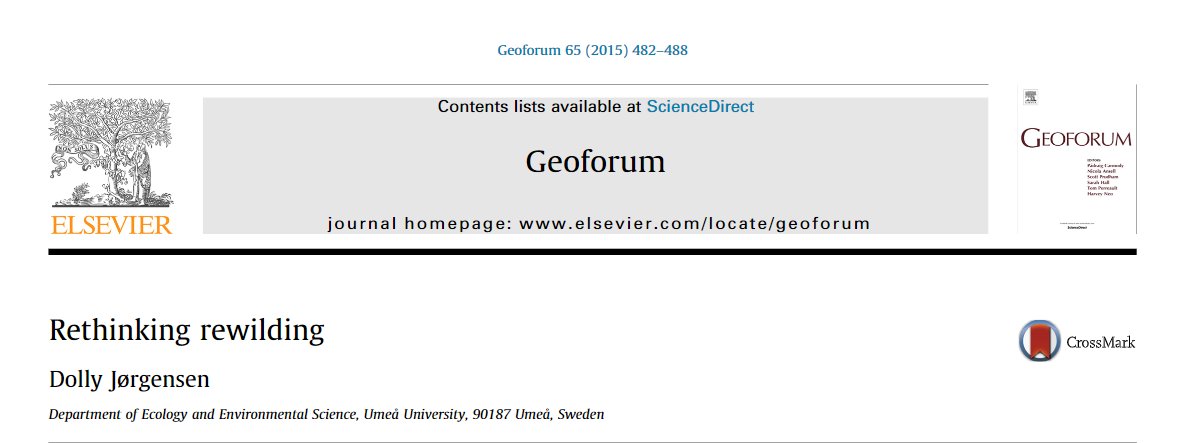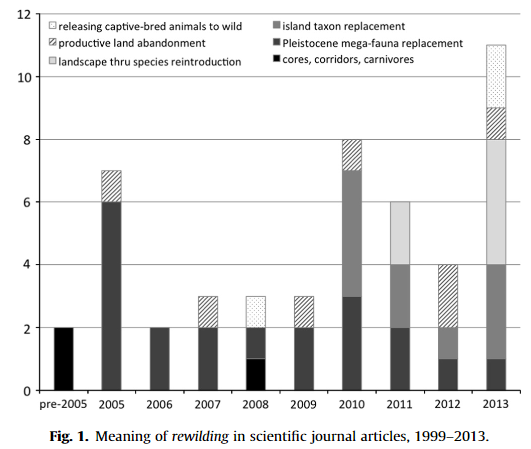1/ Todays #rewildingscience paper sees us take a look at Dolly Jørgensen’s Rethinking Rewilding which investigates how the term rewilding was adopted and modified in ecological scientific discourse - https://www.sciencedirect.com/science/article/pii/S0016718514002504">https://www.sciencedirect.com/science/a... #rewilding #ScienceTwitter
2/ The author starts by pointing out that the term rewilding has not come from nowhere and that ‘Wilderness’ as a conservation target, particularly in the US, has a long history.
3/ The Wilderness Act in 1964 defined it as ‘an area where the earth and its community of life are untrammeled by man’, yet wilderness was also a ‘resource’ for human use.
4/ We then look at rewilding in scientific literature. With its beginnings linked to the Wildlands Project in the US which aimed to create North American core wilderness areas without human activity that would be connected by corridor.
5/ Through literature searches Jorgensen discovered six uses of the word rewilding: (1) cores, corridors, carnivores; (2) Pleistocene megafauna replacement; (3) island taxon replacement; (4) landscape through species reintroduction;
6/ 5) productive land abandonment; & (6) releasing captive-bred animals into the wild. The author points out that each of these definitions has been confined in scientific literature each definition to a set geography, whether that is North America, the Pacific islands, or Europe
7/ Jørgensen then suggests that the original meaning of rewilding as ‘cores, corridors, and carnivores’ has been replaced with a focus on species reintroduction or taxon replacement, often of herbivores.
8/ The author then highlights that these six different uses of the term rewilding occured in scientific literature within a span of 8 years. Suggesting that Scientists have operationalized the concept of rewilding to meet the narrow parameters of given article’s subject matter.
9/ This leads to rewilding being used in very different contexts, from translocating surrogates for extinct tortoise species to reintroducing wolves to letting hedgerows grow unmanaged. To apply a single word to such a broad range of activities could potentially lead to confusion
10/ We then look at rewilding within activist discourse, who’s adoption of the term has shaped it further. We hear about Dave Foreman’s Rewilding North America (2004) founded on the Soulé and Noss (1998) version of rewilding
11/ and Peter Taylor’s Beyond Conservation: A Wildland Strategy (2005), which took a habitat centered approach to conservation, giving nature free rein rather than predetermining the desirable ecological state.
12/ Taylor employs ‘wilding’ much more often in his book than ‘rewilding’, as he advocates habitat creation based on future-thinking rather than past state targets.
13/ We then hear about @RewildingEurope which combines two definitions of rewilding: productive land abandonment with species reintroduction. RE state that Rewilding is about moving forward not back, letting nature itself decide much more and man decide much less
14/ Next #Feral by George #Monbiot is discussed, his rewilding defined as ‘resisting the urge to control nature and allowing it to find its own way’ (2013:9) he promotes reintroducing missing megafauna, incl taxon replacements for the extinct.
15/ This rewilding with reintroduced species would take place on abandoned productive land in Monbiot’s vision. In a way Monbiot combines many of the definitions that have gone before.
16/ Jorgensen believes rewilding has been able to capture the public imagination and that from a position of credibility and authority, rewilding may become the go-to blanket solution to environmental problems
17/ The author concludes the section by suggesting that rewilding has subsumed more discrete and meaningful terms such as animal reintroduction, reforestation, or habitat restoration.
18/ The paper concludes by sumamriazing that rewilding provides an example of how a scientific term can very rapidly enter into scientific and activist discourse, transforming and altering previous ideas, giving them new power
19/ and enabling it to become the focal point of large and complex debates, some of which were not connected before
20/ The author also suggests that rewilding shows us the ability of particular words to capture the public imagination. Suggesting that rewilding has popular appeal because it aims to have a tangible positive effect on a future world
21/ Rewilding shows that its impreciseness enables it to cross the scientific discursive boundary into the political. Its very vagueness and fuzziness lets people appropriate it, yet words like rewilding often lose ‘any potential for precision, concreteness, or exactitude’
22/ We then bring in people and that Rewildings definitions indicate that the ‘wild’ exists at a time when there are more animals and fewer less intrusive people.
23/ The author then quotes Cronon (1995) who says if “wilderness leaves no place for human beings...it can offer no solution to the environmental and other problems which confront us”
24/ The author tells us that this criticism of the ‘wild’ as a place without people was made before rewilding was coined as a term and substantial literature exists about it but that rewilders apparently have failed to take notice
25/ The author calls for a more concrete, specific and future-embracing rewilding to look for places and spaces in which humans and nonhumans can co-exist.
26/ Finally we hear about ‘Rewilding Vancouver’ which is about inclusion rather than exclusion. The paper suggests that this development might signal just another discourse that the vague word ‘rewilding’ has invaded
27/ or more positively, perhaps an inclusive rewilding could become the foundation of a truly rewilded world...
28/ Comments: I really enjoyed this paper, I think its criticisms are mostly fair and well researched. The term rewilding will continue to evolve which risks splitting people further into groups depending on you see the terms true meaning.
29/ There are a couple of key questions here for me, firstly is #rewilding more powerful as this plastic term that people can inprint on, in terms of inspiring change than it is a more rigidly defined outcome?
30/30 And secondly how do we get from vision that many as this paper shows suggest excludes people to one where people are connected and inclusive of that vision?.
#rewildingscience @Nature_Based @OwenMiiddleton @Painting_Nature
#rewildingscience @Nature_Based @OwenMiiddleton @Painting_Nature

 Read on Twitter
Read on Twitter





